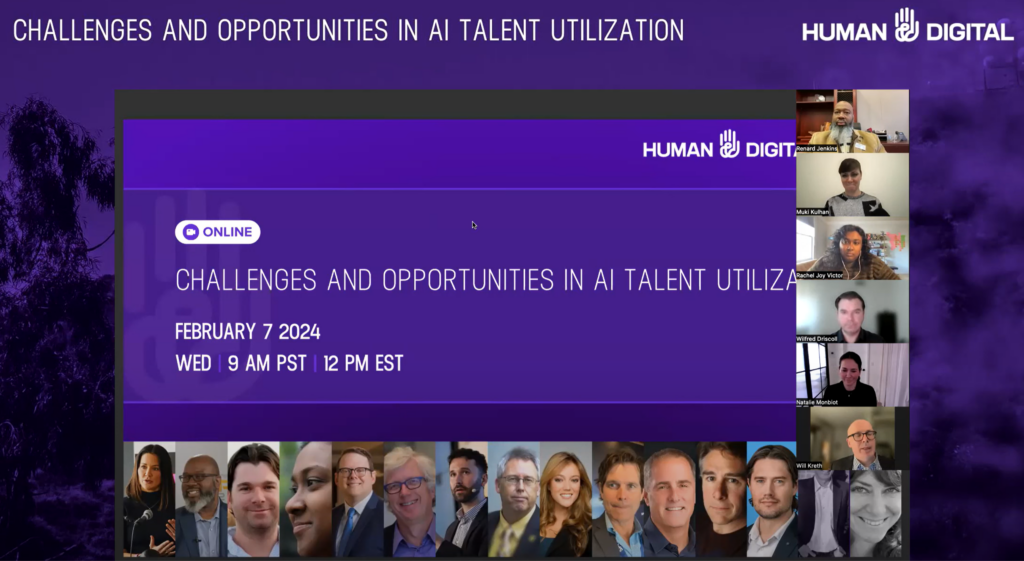
Tech Experts Explore ‘The State of AI Talent Utilization’
Artificial intelligence (AI) experts explored the latest trends in the AI talent utilization ecosystem on Feb. 7, during the first of three panel discussions at the first webinar held by Human & Digital (HAND), “Challenges & Opportunities in AI Talent Utilization.”
To figure out where we are at today, it is “probably best to start around” 10 years ago, according to Renard Jenkins, president of The Society of Motion Picture and Television Engineers (SMPTE).
When it came down to what the supply chain and production pipeline looked like,” he said during the panel session “The State of AI Talent Utilization.”
“Everyone was really into the … space of automation. You heard automation this, automation that. You heard other buzzwords that were thrown around [including] blockchain this, blockchain that,” he pointed out.
 But he said “what we were really focused on at that time was machine learning and automation and figuring out where could we find efficiency within the supply chain? Where could we find efficiency within the production pipeline? And so, when taking a look at that, automation for sort of simple tasks is the first thing that you want to do…. And then how do you move big files faster?”
But he said “what we were really focused on at that time was machine learning and automation and figuring out where could we find efficiency within the supply chain? Where could we find efficiency within the production pipeline? And so, when taking a look at that, automation for sort of simple tasks is the first thing that you want to do…. And then how do you move big files faster?”
That, he said, was really “sort of the baseline of what everyone was trying to do, and then you got the cloud input that came into everything.” Along with the cloud came “some people excited about it, [while] some people had fear. And so the adoption within certain portions of the supply chain have taken a bit longer than they should,” he explained.
But now, however, he said: “We are in a situation where we can finally tell the marketing people that they can actually efficiently use the title of artificial intelligence.”
Many people were “throwing that title around a few months ago, a few years ago, when it wasn’t artificial intelligence, he said; it was truly just machine learning and automation.”
Now, however, we’re at a place where “we could actually build a production pipeline or a supply chain that has the ability to look at itself and look at its performance and adjust, or at least suggest an adjustment that would allow it to improve on what it’s doing.”
He said: “That’s where we are today. I think that’s one of the places that we could actually grow. But a lot of it is going to have to do with the education of the individuals who are in some of the seats to write the checks.”
While some in the entertainment sector continue to fear that AI will cost them jobs, there continues to be fear around the use of deepfakes, panelists noted.
Opportunities, meanwhile, include increased efficiency, panelists noted.
 “In terms of opportunities,” Natalie Monbiot, head of strategy at video technology company Hour One, pointed to a project in which an immigrant in her 60s with “very little knowledge of technology” has written a cookbook. “She’s created [an] AI twin to be able to actually turn her transcript into [a] kind of instructional video. And what I love about that is that’s what’s really helping to build and expand a brand with “very little lift,” she said.
“In terms of opportunities,” Natalie Monbiot, head of strategy at video technology company Hour One, pointed to a project in which an immigrant in her 60s with “very little knowledge of technology” has written a cookbook. “She’s created [an] AI twin to be able to actually turn her transcript into [a] kind of instructional video. And what I love about that is that’s what’s really helping to build and expand a brand with “very little lift,” she said.
She added: “There’s some just really interesting opportunities there which are kind of open, not just top tier talent, that AI an avatar technology can make.”
During the second panel session “Battling Deepfakes,” panelists delved into the ongoing industry efforts to combat deepfakes, as well as the scale of the issue. The third panel session was on “AI Talent Monetization.”
To watch the full presentation, click here.
